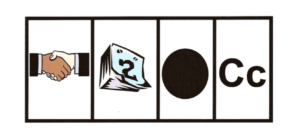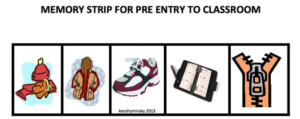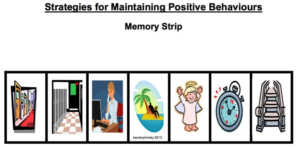Using Memory Strips For Success
Using Memory Strips For Success
Memory Strips
Memory strips are essential teaching tools to assist students who need support with memory recall, organization, making good behavioural choices and using self-regulation strategies. Memory strips can be used in the classroom and at home to reinforce routines and strategies used to regulate behaviour. Memory strips put the student in control of their decisions and improve independence. Typically, students who have difficulties with attention due to Attention Deficit Hyperactivity Disorder, Attention Deficit Disorder and Tourette Syndrome will benefit from this tool that is easy to create and put into action. Adults and “neuro-typical” children may also benefit from using memory strips in their everyday tasks.
For children with difficulties with organization and memory recall:
Memory strips can provide visual cues for procedural steps for work completion and for improved organization. For example, children who have difficulties starting or completing tasks may use memory strips to provide a visual checklist to guide them through steps required to complete or improve the quality of their work. Children who have difficulties with organization can benefit from memory strips reminding them of the things they need to do.
For children with behavioural or self-regulation challenges:
Memory strips can be used to prompt appropriate behaviour choices or to provide cues to strategies that can be implemented by the student to ensure success. Often children who have neurological differences tend toward unwanted behaviours when unsure of what they should do. The memory strip can be a visual cue to give them positive choices and strategies during these moments and preempt the unwanted behaviour.
Here are some examples of simple memory strips I have used to effectively teach students with learning disabilities and/or neurological challenges.
Memory Strip: Start and Finish Written Work
This strip comes from the book “Teaching the Tiger” by Marilyn P. Dornbush and Sheryl K. Pruitt, (Hope Press Inc., 2003). It is used to remind students of basic routine information for starting and completing school work. I have used this memory strip for my entire class, as a constant reminder. It can be taped to a student’s desk, or posted at the front of the classroom for all.
Work Completion Memory Strips: Neurologically Gifted

Frame 1: Introduce yourself. This image reminds the student write their name on the paper.
Frame 2: The calendar image prompts the student to put the date on their paper.
Frame 3: A large period prompt the child to check their work for proper punctuation.
Frame 4: The capital C and lower case C prompt checking their written work for proper capitalization.
Memory Strip: Morning Locker Routine
I created this memory strip for my organizationally challenged son. Having profound difficulty organizing himself at school, I provided him with a memory strip that was posted inside his locker for his reference. At the start of each day, he would follow these steps before entering the classroom.

Memory Strip Entry to Classroom: Neurologically Gifted
Frame 1: Put your hat, mitts and scarf IN your locker. (Especially important if you have to replace lost items frequently)
Frame 2: Hang your coat IN your locker.
Frame 3: Put on your indoor shoes.
Frame 4: Bring your agenda into class
Frame 5: Check your pant zipper (he often has his clothes on backwards too, but I wanted to keep it simple!)
Memory Strip: Using Your Strategies
I created this memory strip for behaviour which prompts recall of strategies to help a student struggling with dysregulation. This dysregulation may be due to suppressed tics, overwhelming stimulus, heightened emotions or even boredom. It is typical for these types of situations to stimulate unwanted behaviour, aggression, provoking behaviour and disruption. The strategies must be known to the student and have worked well in the past. This particular strip was created for a grade 7 student who was profoundly challenged by Tourette Syndrome. This memory strip was posted inside the student’s locker, and on the inside cover of his notebooks. It proved to be very effective, and was consistent with his Behaviour Management Plan. The memory strip provides a consistent reminder of his strategies and school behaviour expectations.
Memory Strip Positive Behaviours: Neurologically Gifted

Frame 1: Take a quick break outside the classroom door (1-2 minutes) (provides an opportunity for a quick release of tics or stress).
Frame 2: Take a walk around in the hall (provides an active release of energy).
Frame 3: Take a time out at the office. The student needs more time to decompress and possibly some distraction from the current situation.
Frame 4: Say it or do it someplace else (leave here and do the tic in a safer place). The student can choose to continue with their current behaviour but in a place where they are more comfortable and safe.
Frame 5: Say or do something else (stay here, but change the tic). The student can check in and choose to redirect their focus and energy.
Frame 6: Take a time out (leave the area and go to the office for support). The student needs to have some adult support to manage the situation.
Frame 7: Use the 3 steps to managing conflict (a process I created for schools). The student chooses to appropriately manage the situation causing dysregulation.
Memory strips are easy to create, and should be created with the student. All memory strips can be tailored to the specific needs of the student improving their independence and success. The student takes ownership of the memory tool by searching online for icons that they “connect to” and pasting them into the frames. By allowing the student to co-create the memory strip with you, they are more likely to remember and use the tool.
Consistent use of memory strips lead to these steps and skills being memorized and becoming “second nature” to the individual. Be sure to share the strips between home and school as the student likely has the same challenges in both situations.
Memory strips give students power and confidence knowing that they can effectively use the guidance within the strip to be successful!


